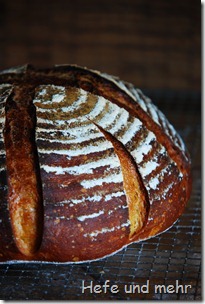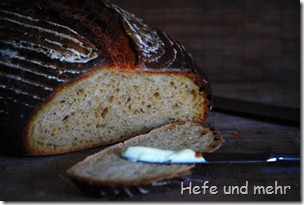
Since Christmas I did not precipitate at Bread Baking Day. The last month were filled with all the things that happen, when you finish your Ph.d. thesis: long days in lab for the last experiments, then writing (and rewriting) the thesis and at least learning for the Disputation. But luckily everything is done now and I can concentrate on things I love: Baking Bread.
BBD is hosted from Sarah From Snuggs Kitchen in this month and has the theme “Bread with vegetable”. And when I thought what to do with some sweet potato leftovers, I decided to put it in a bread. And the chickpea flour (chickpeas are vegetables, too) I neglected for a to long time would be a nice addition, too. And so I went to work in my kitchen, making bread with sweet potatoes and chickpea flour.
I had to reduced the amount of water which I added to the dough because the chickpea flour makes the dough very soft. But then handling the dough was possible and I placed the loaves in some proofing baskets and let them proof overnight in the fridge.
While I baked the loaves the next morning, the fragrance of chickpea filled the kitchen. And when I take the loaves out of the oven, they started to “sing” immediatly. The crackle of their crust already promised a crispy crust with a soft crumb. And the colour of the crust was stunning, too: A dark brown with deep orange slashes, with accents of white flour. A bread for all senses.
Sweet potato & Chickpea Bread
Sourdough
- 175g flour Type 550
- 120g Water
- 15g sourdough
Dough
- 775g flour Type 550
- 150g chickpea flour
- 100g whole rye flour
- 300g sweet potato (cooked and mashed)
- 650g Water
- 30g Salt
- 5g fresh yeast
In the evening mix water, flour and starter for the sourdough and ferment for about 10 –12 hours at 25°C.
Mix all ingredients for the dough and knead it for about 5 min at low speed, then 8 min on high speed until medium gluten development.
Ferment for 2 hours.
Half the dough and form each half to a round loaf. Place each loaf in a proofing basket, with seam side up.
Proof overnight in the fridge,
In the morning heat the baking stone at 250°C.
Prior to baking, slash the loafs and bake the breads for 45 min at 250°C with steam.
I sent this entry to Yeastspotting, Susans weekly showcase of yeast baked good.
Deutsch



Liebe Stefanie,
Ich weiß nicht wie es diesem Rezept gelungen ist, sich die ganze Zeit vor mir zu verstecken. Ich liebe die Kombination von Süßkartoffeln und Kichererbsen! Aber es enthält meinen Angstgegner – Sauerteig. Meinst du man könnte ihn durch einen anderen Vorteig ersetzen oder vielleicht anstatt Wasser Buttermilch verwenden?
@Jana: Ich würde einen Poolish aus 175g Mehl Type 550, 175g Wasser und 0,1g Hefe ansetzen und etwa 16 Stunden gehen lassen. Im Hauptteig musst du die Wassermenge dann aber auf 595g reduzieren 🙂
Der Teig ist ziemlich matschig! Ich habe noch drei große
Löffel Mehl zugegeben, hoffe, es wird beim Gehen besser.
Liebe Grüße Ulrike
@Ulrike: Mehl unterliegt natürlichen Schwankungen, die sich auf seiner Fähigkeit, Wasser aufzunehmen, auswirken. Darum empfiehlt es sich, beim Kneten zuerst 5-10% der Wassermenge zurückzuhalten, und erst nach und nach zum Teig hinzuzugeben, um die natürliche Schwankungen der Wasseraufnahme des Mehls auszugleichen. Weitere Gründe für klebrigen Teig findest du hier.
Hallo Stefanie,
könnte ich den Teig auch ohne gehen direkt in Den Kühlschrank legen und ihn erst am morgen formen, gehen lassen und dann in den Ofen?
@Rebecca: Das sollte auch funktionieren.
Hallo.
Wer kann mir sagen, woher man Kichererbsenhefe her bekommt bzw. wie man diese herstellen könnte? Danke im voraus
@Ayvaz: Das KichererbsenMEHL habe ich in einem Indischen Supermarkt gekauft, du kannst es aber auch z.B. hier kaufen.
Hi Stefanie,
Thank you for your participation. The bread looks very tasty!
love greetings
Sandra
Wonderful texture
Hallo Stefanie, tolles Rezept 🙂 Meinst Du, man könnte das Kichererbsen- durch Buchweizenmehl austauschen, das ist ja beides glutenfrei? Herzlichst
Nadja
@Nadja: Das kann man bestimmt. Bei meinem letzten Brot mit Buchweizen hatte ich es in einem ähnlichen Verhältnis eingesetzt.